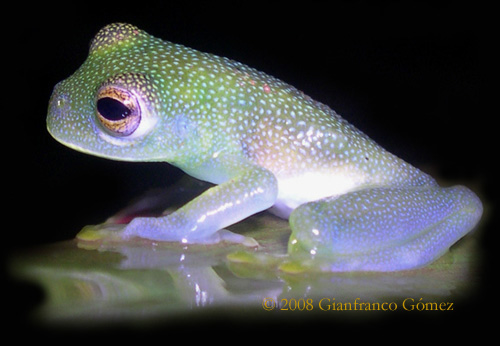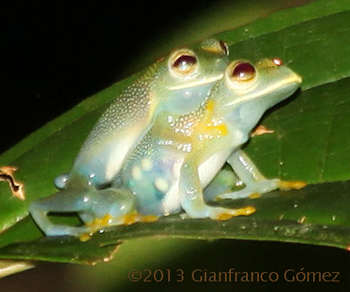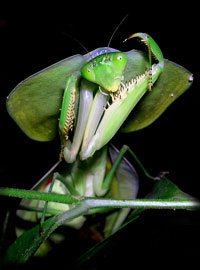|
Discover the
hidden treasures of Drake Bay, Costa Rica with Tracie "The Bug Lady"

Home

Tour
Basics

Meet the Bug
Lady

Tales from the
Edge

Media

Reservations

Links



Facts about Drake Bay, Costa Rica

Travel To Drake Bay

Drake Bay Area Map

Hotel Information

Tips for Travelers

Tours

Recommended
Reading





|
|
|
|
|
 |
|
|
      |
|
|
|
|
|
The
Granular Glass Frog |
|
Cochranella
granulosa |
|
|
|
|
|
 |
|
|
|
The Granular Glass Frog is found
throughout the humid lowlands of Honduras, Nicaragua, Costa Rica, and
Panama. The common name is due to the skin's granular texture. Adults
may measure from 23 to 32 millimeters.

Underneath,
the abdomen is transparent and the red ventral vein as well as the
intestines are visible. The intestines are covered by a white
membrane. In some individuals the red liver may also be visible.
They are normally found near fast moving streams, where
males call from the upper surfaces of leaves. A male frog typically protects
a calling territory, and if a rival male dares trespass, it gets ugly
fast! Males have been observed engaging in sumo-style wrestling matches.
They hang upside down, on the edge of a leaf, by the tips of their toes
while clashing chest to chest and grappling fiercely in an attempt to
dislodge each other. It may go on like this for over two hours!
|
|
 Once his territory is
secure, the male will generally call from high vegetation
overhanging a moving stream. He will usually move around and try out
a few different calling perches as the evening progresses. Their
call is a harsh "creep-creep-creep" normally repeated two or three
times. When making their advertising call, males will call
over each other in an attempt to drown out rival males. Because they
often call perched high above our heads, seeing them is often
difficult. Once his territory is
secure, the male will generally call from high vegetation
overhanging a moving stream. He will usually move around and try out
a few different calling perches as the evening progresses. Their
call is a harsh "creep-creep-creep" normally repeated two or three
times. When making their advertising call, males will call
over each other in an attempt to drown out rival males. Because they
often call perched high above our heads, seeing them is often
difficult.
 If the male successfully
attracts a female, she will approach him and they will mate. She will normally lay her
egg clutch several meters above a stream, on the tips of leaves. Egg
clutches are made up of a thick, clear jelly mass and may contain
between 40 and 70 eggs. The eggs will develop
for 13 to 17 days and, after hatching, it will take several months
for the tadpole to complete it's metamorphosis. If the male successfully
attracts a female, she will approach him and they will mate. She will normally lay her
egg clutch several meters above a stream, on the tips of leaves. Egg
clutches are made up of a thick, clear jelly mass and may contain
between 40 and 70 eggs. The eggs will develop
for 13 to 17 days and, after hatching, it will take several months
for the tadpole to complete it's metamorphosis.
When the froglet is
ready to emerge, as seen below, it leaves the water still sporting a
long tadpole tail. |
|

Upon reaching dry
land, it will remain fairly inactive for about five days while
absorbing it's tail. This provides the young frog with nourishment
and it will have no need to feed until the process is completed.
|
|
|
|
References:
Kubicki, B. 2007
Costa Rica Glass Frogs
Editorial INBio
Leenders, T.
2001 A Guide to Amphibians and Reptiles of Costa Rica
Zona Tropical
Savage, J. 2002 The Amphibians and Reptiles of
Costa Rica University of Chicago Press
|

|
|
|
|
The Frog
Files





     






 |



 Alien Earthlings
Alien Earthlings  The
Dark Side
The
Dark Side













 Once his territory is
secure, the male will generally call from high vegetation
overhanging a moving stream. He will usually move around and try out
a few different calling perches as the evening progresses. Their
call is a harsh "creep-creep-creep" normally repeated two or three
times. When making their advertising call, males will call
over each other in an attempt to drown out rival males. Because they
often call perched high above our heads, seeing them is often
difficult.
Once his territory is
secure, the male will generally call from high vegetation
overhanging a moving stream. He will usually move around and try out
a few different calling perches as the evening progresses. Their
call is a harsh "creep-creep-creep" normally repeated two or three
times. When making their advertising call, males will call
over each other in an attempt to drown out rival males. Because they
often call perched high above our heads, seeing them is often
difficult.
 If the male successfully
attracts a female, she will approach him and they will mate. She will normally lay her
egg clutch several meters above a stream, on the tips of leaves. Egg
clutches are made up of a thick, clear jelly mass and may contain
between 40 and 70 eggs. The eggs will develop
for 13 to 17 days and, after hatching, it will take several months
for the tadpole to complete it's metamorphosis.
If the male successfully
attracts a female, she will approach him and they will mate. She will normally lay her
egg clutch several meters above a stream, on the tips of leaves. Egg
clutches are made up of a thick, clear jelly mass and may contain
between 40 and 70 eggs. The eggs will develop
for 13 to 17 days and, after hatching, it will take several months
for the tadpole to complete it's metamorphosis.








